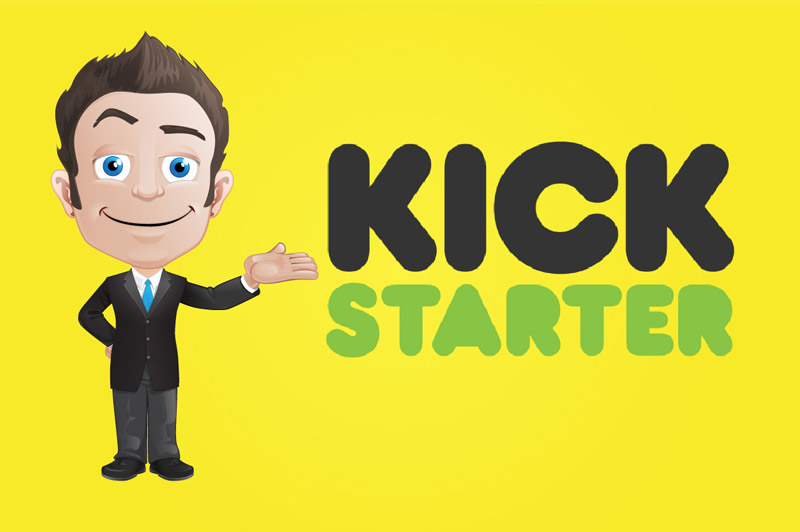Kickstarter Crowdfunding Review 2019
Ratings, Pricing & Comparisons
Is Kicksarter the best Crowdfunding website for you?
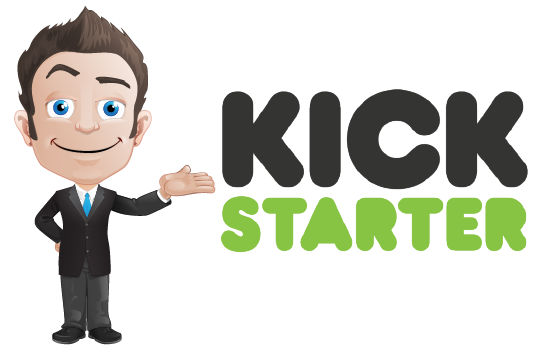
With lower marketing costs and online technology which allows us to globally connect with customers, now is the perfect time to start up a new business.
However, there’s one issue…
Entrepreneurs need to raise investment funds to get started!
Well, don’t worry – there’s good news!
Kickstarter was founded back in 2009 and is a crowdfunding site which focuses on collecting funds for projects of a creative nature. Kickstarter covers a wide range of areas which include, games, films, art, music, technology, and design. Kickstarter isn’t simply about giving money to back projects, its more about helping to support an individual’s dream about creating something that they want to see implemented within the world.
Kickstarter’s model type is that of a donation/reward. What this means is that those who support and donate to a project are able to take a sneak peek into the creative process as well as choose from a selection of unique rewards which the project creator has on offer. Of course, each project has different rewards, but more often than not, it usually includes sample of what is being created (e.g., a DVD, book, CD, etc), or even some form of experience which is completely unique to the project, for example having a meet and greet with the creator or even receiving producer credits.
Project creators are able to keep 100% work ownership, and because Kickstarter is that of a rewards model, it can’t be used to solicit loans or offer financial returns or equity. The great thing is that being a reward model creatives or artists are able to keep complete project ownership.
The thing is, with so many crowdfunding platforms available, it can be difficult to know who to choose.
Don’t worry…
To help you make your mind, I have reviewed what exactly Kickstarter has to offer including what type of crowdfunding it is suited to.
So, if you’re ready, grab a cuppa, get comfortable and let’s get cracking…
I will put Kickstarter through our rigorous testing and will look at the following aspects.
Performance:
How does Kickstarter perform and what features does it offer to help create the perfect crowdfunding campaign?
Usability:
Does Kickstarter offer everything necessary that users expect from a crowdfunding platform?
Support:
Does Kickstarter offer quick customer support solutions and help, and can users count on them when it matters most?
Cost:
Does Kickstarter offer the best pricing in the marketplace? And more importantly, what deals are available that can help users save money?
Performance
With Kickstarter, it is easy to track backer rewards and pledges plus it can easily be linked up to Google Analytics to provide more detail. Their survey tools make collecting backer information and mail addresses quicker and easier.
Cost
Like most other crowdfunding platforms, Kickstarter charges a percentage of all monies raised together with processing fees via Stripe. If the goal is not reached, then all monies will be refunded – perhaps not as flexible as other crowdfunding groups.
Usability
Setting up campaigns is easy with Kickstarter, especially as it basically walks users through the process.
Support
Kickstarter doesn’t offer much in the way of customer support. The only way is by submitting a support ticket then waiting to be contacted by email.
We Like
- Excellent media outreach
- Suitable for larger businesses
- Standard industry fees
- Easy to use online tools
- Offers a wide reach
- Is considered as one of the most creative/popular crowdfunding sites
- Integrates with Google Analytics
- Detailed tracking of campaigns
We Don't Like
- Customer support is limited
- All-or-nothing- funding model type
- Not all project proposals are guaranteed to be accepted
- Rewards for donors is a requirement
- Implements tighter funding restrictions than some of its competitors
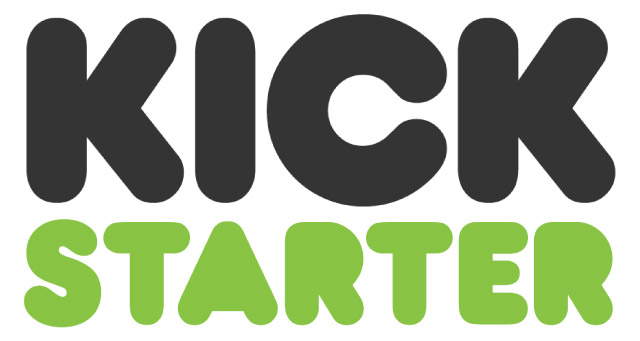
Introduction
Since about the mid-’90s, there seem to have been several attempts to utilize the attention-aggregation power of the internet in order to raise funds for projects, people and institutions who would, in normal circumstances struggle to receive funding.
Kickstarter launched on April 28th, 2009 and focused partly on monetizing the social identification that the internet generation had with the ethos of the creative classes, which then led to Kickstarter identifying itself as a platform for creative projects rather than those for personal use or charity.
The main thing to remember is that before any funding is received, the fundraising goal must be met and within a specific time period otherwise NO FUNDING at all will be received. Also, if a project does come into fruition, then ‘rewards’ MUST be provided for all backers and MUST be the creation of the creator.
Kickstarter claims to have had pledges totaling over 3.9 billion dollars to their projects, over 15 million backers in total and has overseen 151,000 successful projects.
To show how committed it is to social responsibility, back in 2015, Kickstarter reincorporated and became a Benefit Corporation which meant that when corporate decisions were made, there was a legal obligation for the societal benefits to be considered rather than simply the shareholders.
#1 Ease of Use
If a crowdfunding site is difficult to use or understand, then the chances are that no-one will want to use it. A good way is by having a look at the startup process, if it’s tough, to begin with then this most definitely is not a good sign.
The question is though, is Kickstarter as easy to use as it claims to be? Well, keep on reading and let’s find out…
So, before we get in too deep, let’s have a look at what requirements need to be met before applying to launch a project with Kickstarter:
- Potential project creators must be a permanent resident of one of the countries that are listed in the Services Offered area
- The project must be created in either the name of the project creator or that of a legally registered entity of which they are associated
- Project creators must be over 18 years old
- If the project is run as an individual, then the bank account that is linked must belong to the project creator
- Project creators must have a major debit or credit card
- Project creators must have a bank account, address, together with a Government issued identification from the country in which the project is being created
Setting up a project using Kickstarter is fairly straightforward. The process begins on their website, where potential project creators will need to select a category followed by verification of eligibility. Some basic information regarding the campaign will then need to be inputted together with the shipping and rewards costs. To establish the story behind the funding, add in a detailed project description and a video. Include profile information with links to the social accounts and then project creators will need to confirm their identity.
Once the project has been submitted for review, it will either flag up for additional scrutiny – which could mean a launching delay of up to three days or will be accepted which means that the launch can take place straight away.
On average 80% of projects that are submitted to Kickstarter are accepted – which isn’t too shabby!!.
Good news…
Kickstarter details its different processing steps clearly and concisely on their website, AND it doesn’t feel deceptive or sales-y. Kickstarter has little incentive to try and lure people to their platform who aren’t serious because they only receive fees on fundraising campaigns that are successful.
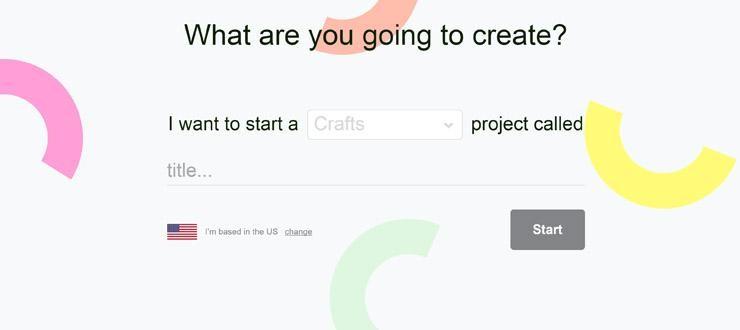
How to Create Fundraising Campaigns
It is quite easy to set up campaigns using Kickstarter. The platform more or less takes you step by step through the process, while at the same time offering tips and advice along the journey. It’s clear to see what rules apply and which elements need to be included in a campaign such as images or videos in order for it to be successful.
Login is either through Facebook or by creating your own credentials.
Once signed up, fundraiser creators can either start a new project or explore existing ones. There are fifteen categories in total which include crafts, technology, comics, and journalism. The great thing is that before you leap in, a tour of the process can be taken – something I found really useful.
Another feature that I loved was that before a project goes live, I was able to preview the campaign and share it with my friends which provided extremely valuable feedback.
Once a category has been chosen, then the project will require a name, image, blurb, and sub-category (this is optional).
Similar to Indiegogo, Kickstarter also has a challenges and risks area. This is where potential stumbling blocks, once funded can be outlined together with what qualifications you have to deal with them.
This section is important, and once the project is live, a frequently asked questions (FAQ) can be added in.
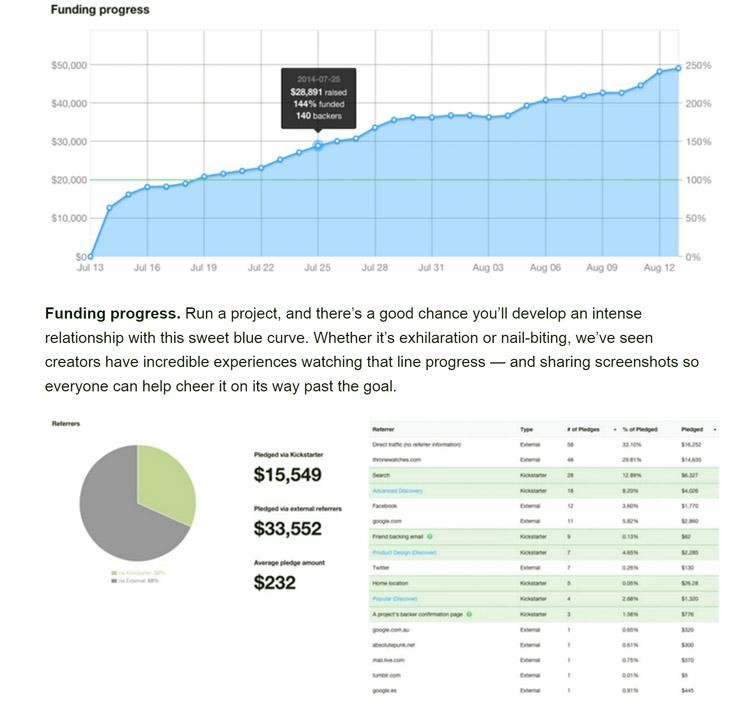
Unlike other platforms, for example, Patreon which permits ongoing fundraising and GoFundMe which doesn’t have deadlines, Kickstarter projects must have a set funding period.
This can be done by either setting a specific end time and date or by selecting the number of days. For the most success, Kickstarter suggest running campaigns for 30 or fewer days. Keep in mind that once the project has been launched, the duration can’t be changed.
Last but by no means least, a fundraising goal will need to be set. This must be inclusive of the amount required for project completion as well as the fulfillment and shipping of any associated rewards.
It is compulsory for all projects to have associated rewards – plus it’s a great way of attracting donors.
There is no set amount of rewards that can be offered. The quantities of each can be limited or even based on the pledged amount.
An example of this could be offering badges for a $10 pledge or signed posters to the first 15 people who pledge $100. Kickstarter has a help community called ‘Campus,’ and this offers a shed load of inspiration on how to create rewards plus they also highlight the most popular ones.
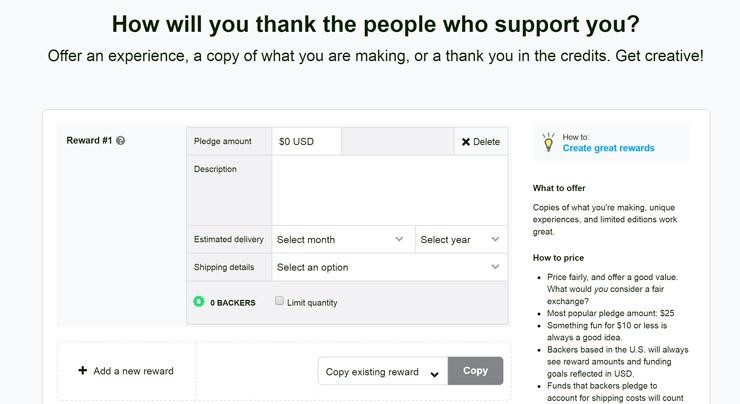
Now, like most things these days, there are limits that surround the rewards. They must not be alcohol, resales or travel services plus all of the rewards MUST be designed or produced by the creators. Remember, when filling out a reward description avoid using phrases that will raise a red flag, for example ‘beer glass’ because if you don’t before you know it, the alerts will come flying in.
Verification
The next step is the verification process. Your account can be verified either by text message, automated phone call or email, following this you must then verify your identity. This must be done by providing proof of your legal name, address, date of birth together with the last 4 digits of your social security number.
This is different from GoFundMe which actually asks for the entire number which could then leave you open to identity theft or fraud should there ever be a security breach.
Next, select the fund destination – this can either be a legal entity or an individual plus provide bank account transfer details. The final stage is to add in a payment source, in the event that one of the backers disputes the credit card charge. Kickstarter does try to resolve any disputes on your behalf; however, if the case isn’t won, then the card will be charged.
Kickstarter includes a myriad of online resources which can help to both create and promote a campaign and from what I’ve seen so far, is a brilliant platform from which to raise funds and promote projects.
Verdict – Kickstarter is easy to use, and the set-up process is outlined step by step which makes it the perfect platform for those who aren't overly ‘techie.'
#2 Customer Support
One thing that I consider to be really important when testing and reviewing anything is what support is available and what shape and form it comes in. After all, we’re all human and need help at some time or another, and I want to know that when (not if!!) I need it, that it isn’t too far away.
In this section, we’ll have a look at exactly what help and support Kickstarter has to offer.
Are you ready? Good, then let’s get cracking…
So, if you find yourself running into difficulties when using Kickstarter one of the first places to start looking for help is in their help center. This can be done by typing in the URL: https://help.kickstarter.com/hc/en-us. You will then be directed to the main page as illustrated below:

Then just click on the question that relates to your query or type in the main keywords of the problem into the search bar.
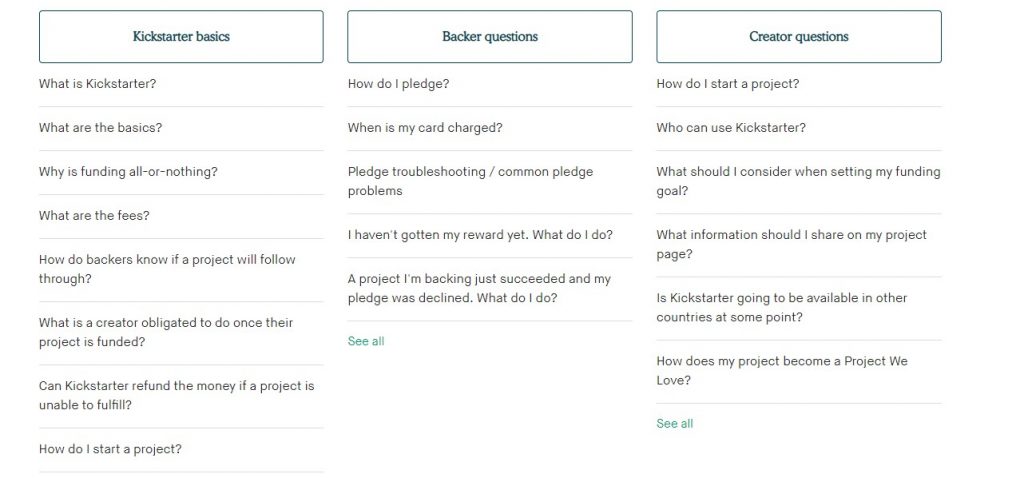
Now, to fix a problem that isn’t covered in the course or in the help center, then it is time to contact the customer services department. The five simple steps below, illustrate how this can be done:
1 Open the web browser and go to the URL www.kickstarter.com, then log in
2 Scroll right to the bottom of the screen where you will see the category labeled ‘Help,’ click on ‘Support.’
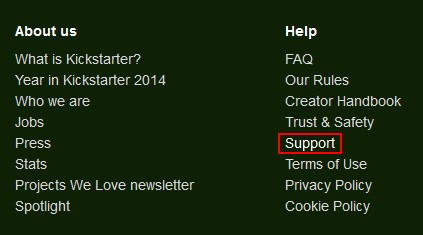
3 Underneath ‘My Stuff’ or ‘General Questions’ click on one of the chief categories. This will then open up a list of sub-categories. From this select the one which matches to what you wish to know.

4 Kickstarter then provides you with a probable solution which will be displayed underneath the sub-category box. If help is still required, then simply click on the button marked ‘Open a Support Ticket.’
5 Once the support ticket has been opened, click on the ‘Subject’ box and type a quick overview of what the issue is. Next click on ‘Details,’ then provide a more in-depth description of the exact issue. When completed, click ‘Submit Ticket.’

Check the messages inbox (to do this click ‘Me’ which is located in the top right-hand corner then ‘Messages’) or alternatively check your email inbox for any replies and to find out how Kickstarter can help you.
Kickstarter can also be reached by emailing: [email protected].
Well, what can I say, although Kickstarter might be the King Kong of Crowdfunding platforms, this isn’t reflected in their customer support levels or options. Although there are a couple of different ways to contact Kickstarter, for issues that aren’t resolved simply by reading their troubleshooting questions a support ticket must be raised and then that’s it, you’ve just got to sit back and wait to be contacted – via email!!
What this doesn’t do, is give both project creators or backers quick support access at a time when they need it most and no doubt when the clock is ticking.
Verdict – To be honest, the Customer Support options were very limited as was the timescale of replies. From such a forward thinking and detailed platform, this was extremely disappointing.
#3 Networking tools and features
It’s always a good idea to have a look at what social networking tools a crowdfunding site offers together with what reporting features are offered. As social networking is a crucial piece of crowdfunding, these features are essential. Also, does the crowdfunding site have an active community and more importantly one that is suited to your cause?
If it hasn’t then you need to really ask yourself, what exactly are you getting from the platform fee?
So, what does Kickstarter have to offer? Come on, let’s find out…
Promoting and Tracking the Campaign…
When you are satisfied with the campaign, there are two options: either to launch it straight away or to submit it, to allow for feedback. Kickstarter checks that the project is compliant with all of its regulations by using an algorithm. If red flags are displayed, then Kickstarter will manually review the project and, when applicable provide feedback. This can take up to three businesses days, and those who are really lucky could end up being listed in Kickstarter’s curated ‘Projects We Love’ showcase, of which it heavily promotes.
Kickstarter makes tracking pledges and backer rewards easy plus for even more detail it can be linked up to Google Analytics. The dashboard will display your progress and will provide a referral report which will outline where backers are actually being sourced from, e.g., promotions or social media.
Kickstarter also enables project creators to see exactly how many viewers are watching their project videos. And if that wasn’t enough, it also provides a backer report which displays individual pledges and allows requests of extra information in order to fulfill any rewards, plus the survey tool is great for collecting backer information such as mailing addresses.
Then there’s the Campus…
When working on any new projects, it always encouraging to know that there is a solid team of supporters waiting in your corner. Kickstarter has taken heed of this and went on to launch a Campus which provides just that.
The Campus is an area where creators are able to connect with one another and ask advice or questions about any problems they are facing as well as be able to trade insights into how the creative process works.
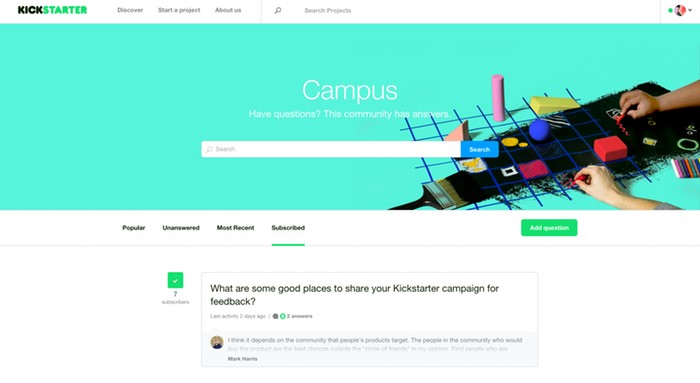
The Campus is a growing part of Kickstarter’s work to give creators the ability to seek the help and support they need as well as connect with peers in order to help bring life into their ideas. The Campus helps to provide the community of Kickstarter’s a space which facilitates knowledge sharing and provides encouragement for those aiming to run a fruitful project.
Verdict – Kickstarter does offer several reporting features and tools which makes collecting backer information and donor history much easier to access, and the added bonus of The Campus provides an active community for any budding Kickstarter’s.
#4 Platform Fees
Platform fees are when a crowdfunding site takes an amount or percentage of the monies raised for either yourself or your cause; I guess it’s kind of like paying for the privilege of actually using the platform.
These fees can range from anywhere between 5-12%.
Be careful though, as some fees can increase if the goal isn’t met, while others offer an ‘all or nothing’ model which means that if the expected goal isn’t reached then no funds are received at all.
So, how did Kickstarter rate with their rates, well wait, keep reading and find out…
Like most other crowdfunding sites, Kickstarter does take a percentage of the monies raised. It takes 5% of the funding total and its payment partner – which is Stripe – also charges processing fees which vary between 3-5%, depending on the amount that is pledged.
Potential donors can be based worldwide and can pay via a debit or credit card; however, project creators must be located in Canada, the US, New Zealand, Australia or from specific European countries. If a project fails to meet its target, then any would-be donors are refunded, and no fees are due.
It is worth keeping in mind that if a project isn’t successful the first time around it can always be re-launched. Funds are normally received within two weeks once a successful campaign has finished.
To make things easier and for the purpose of this review, the illustration below outlines Kickstarter’s terms and fees.
When it comes to working out how much funding will be required to realize your dream, don’t forget to factor in how much extra the fees will gobble up.
A funding period can be set for no longer than 60 days; however, the recommended time by Kickstarter is less than 30 days as previous data has shown that lower time based listed are the most successful.
Verdict – Kickstarter offers a pretty standard level of fees, but users must keep in mind payment partner fees as well.
Is Kickstarter the right crowdfunding platform for you?
Of course, Kickstarter won’t be the correct crowdfunding platform for everyone, so let’s try to get down to who precisely this platform is best suited to.
Budget
As Kickstarter’s fees are pretty standard compared with their competitors, it could be an option for those counting the pennies. Because its ethos is based on all or nothing, if the target isn’t reached there is the danger of no funds whatsoever being received, which makes it a little less flexible than some other options that are available.
Beginners
Kickstarter is suitable for those just starting out as it is fairly easy to set up and use, however, if any problems are encountered further down the line, then their lack of customer support could be an issue.
High-Level
Kickstarter is suitable for high-level projects as it allows potential project creators to determine themselves what their funding goal will be. This is really beneficial for those who a seeking a much larger goal that would normally exceed the limitations of other crowdfunding platforms.
Summary
Well, that’s it I’m now nearing towards the end of this review, and I hope that it has given you an overall idea what Kickstarter is about and what if has to offer. I’m guessing though that the final and most important question is – Is Kickstarter THE ONE, I mean the right crowdfunding platform for YOU and your campaign?
Kickstarter is a super platform for any creative individual who is looking to breathe life into their dreams with the added bonus of not having to hand over any equity or pay any outrageous fees.
Potential users, however, could be faced with uncertainty around the warning areas of slow fund disbursement, the all or nothing funding type, lack of customer support and mediocre success rate.
That said, Kickstarter does still sit pretty high in the crowdfunding world and still remains a good place to seek out support from those in the creative community especially for projects involving films, art or games. For those who have projects that are likely to pique interest from geeks, hobbyists and other creative types who are desperately looking to become involved in the ‘next big thing’ then Kickstarter is certainly one avenue which is worth looking down.
Some have questioned Kickstarter’s usefulness to the creatives and small-time inventors that crowdfunding itself was supposed to benefit in, to begin with, but do you know what – it sure beats trying to take out a bank loan!!

Disclaimer
(The EntrepreneursGateway.com team are committed to produce independent, thoroughly researched and comprehensive guides and reviews for the best products and services that will help you in your business and your life. If you like what we do, you can support us through our chosen links, which earns us a small amount of commission which helps us fund our research and maintenance of the blog to better help you. Learn more about our Review Process.)
Now, over to you...
Now I’d love to hear from you:
Are you still unsure of which crowdfunding website is best for you?
Maybe you’ve tried Kickstarter before and would like to tell us about it?
Leave any comments below and I will be sure to answer as soon as they come in!

